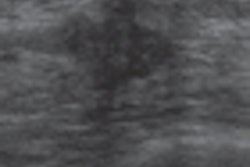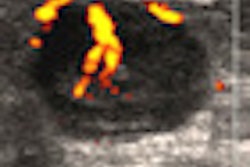A 2009 law passed in Connecticut that requires women with dense breast tissue to be notified of their status has led to a "flood" of screening ultrasound exams at breast clinics in the state. The phenomenon could occur in other states that are considering similar laws, according to a presentation at the recent RSNA 2011 meeting.
Teams from Yale-New Haven Hospital and the Hospital of Central Connecticut reported on the efficacy of breast ultrasound in dense breast tissue: So far, the results have been mixed. They also addressed how the increase in ultrasound imaging has affected their practices.
Their experiences could serve as a model for other states where legislation has either already been adopted -- such as Texas -- or is currently on the legislative front burner.
A flood of screening
Dr. Kathryn Greenberg, of Yale-New Haven Hospital, and colleagues investigated the performance of handheld screening breast ultrasound in women with dense breast tissue, in part to track the effects of the Connecticut law. They found that breast ultrasound's overall cancer detection rate was 0.32%, comparable to that of mammography. However, they also found that adding breast ultrasound screening to the mix changes a practice's workload.
"Prior to October 2009, [when the Connecticut law was passed,] we did not perform screening ultrasound at our institution," Greenberg told session attendees. "Since the law was passed, there's been a flood of screening breast ultrasound. I myself do about 40 ultrasounds per day."
Greenberg's team performed a retrospective review of 935 women with dense breasts on mammography who subsequently underwent handheld screening breast ultrasound between October 2009 and September 2010. The average length of time between mammography and ultrasound was 60 days, Greenberg said.
Sixty biopsies were performed in 52 patients out of the total cohort. Fifty-seven of these biopsies proved benign, and three proved malignant (all three malignancies were BI-RADS 4 lesions), Greenberg's team found.
Although the overall cancer detection rate was comparable between breast ultrasound and mammography, the overall positive predictive value for biopsy of these BI-RADS 4 lesions was 5.9%, quite a bit lower than mammography's 20%.
How much time did these ultrasound screening exams take, and who performed them? In the beginning, Greenberg's group scheduled 45-minute time slots, and the exams were performed by technologists who had received training in breast ultrasound and were supervised by physicians, according to Greenberg. As the group's technologists have become more experienced, the time slots for the exam have been reduced to 30 minutes.
Greenberg's practice has gotten creative to handle the overflow, she said.
"There's a growing trend to do screening breast ultrasound after hours, and if the technologist thinks there's an issue, the patient is pulled back for a diagnostic ultrasound during the day, with a physician," she said.
Breast ultrasound works ... sort of
In a related study, Dr. Jean Weigert, of the Hospital of Central Connecticut, and colleague Dr. Sarah Steenbergen, from the University of Connecticut, investigated whether screening breast ultrasound improves breast cancer detection in women with mammographically normal but dense breasts. They presented their findings in a poster at the RSNA meeting.
Weigert and Steenbergen conducted a retrospective chart review throughout Connecticut on the use of breast ultrasound exams for women with normal but dense breasts on screening mammography. They collected the total number of screening mammograms, screening ultrasounds broken down by BI-RADS codes, and the number of positive and negative biopsies from sites throughout Connecticut, as well as demographic data on the patients with positive biopsies and cancer staging.
The two researchers obtained data from five Connecticut radiology practices with more than 50,000 screening mammograms and more than 8,000 screening ultrasounds; about 40% of the patients included in the study had dense breasts. Of those patients, an estimated 50% received a follow-up breast ultrasound, Weigert said.
Weigert and Steenbergen found that breast ultrasound in women with mammographically normal but dense breasts had a positive predictive value of 4%, a negative predictive value of 99.9%, sensitivity of 94%, and specificity of 52%.
Although breast ultrasound can be effective in finding cancers missed by mammography, the extra time, cost, and risk of false positives must be considered as well, they concluded.
"Once the American College of Radiology Imaging Network 6666 trial demonstrated that ultrasound could find cancers that could not be seen on mammograms in women with dense breasts, we knew we would be unable to lobby against the legislation and remain credible in the eyes of the legislators," Weigert told AuntMinnie.com. "But we remained concerned about the problem of the many potential false positives, as well as implementation -- never mind the fact that it's still unclear whether ultrasound improves mortality odds like screening mammography does."
A movement's roots
Why has Connecticut been ground zero for breast density reporting? The state has the second highest incidence of breast cancer in the nation, according to Weigert, and ranks 16th in the nation for breast cancer mortality rates. But the Connecticut bill was also prompted by the experience of Nancy Cappello, PhD, a Connecticut woman who received a diagnosis of advanced-stage breast cancer in 2004, at age 51.
Because Cappello had dense breast tissue, her cancer was not discovered by annual mammograms, even though she had already received more than 10. To address the issue of breast density, Cappello founded Are You Dense, an organization that urges women to be informed about dense breast tissue and how it affects the early detection of breast cancer.
Out of Are You Dense has come the Density Education National Survivors' Effort (DENSE), a grassroots organization that supports further breast density notification legislation. The group's efforts have proved fruitful in at least one other state: In June, Texas became the second U.S. state to mandate the inclusion of breast density risk language in reports sent to women after their mammograms. HB 2102, also known as "Henda's Law," took effect September 1.
More recently, however, breast density notification advocates received a setback when California Gov. Jerry Brown vetoed similar legislation in October.
Cappello's group has vowed to move forward despite the setback in California. A federal bill (HR 3102) was introduced in Congress soon after Brown vetoed the California legislation, and a number of states -- Kansas, Ohio, New Hampshire, New York, Virginia, and Pennsylvania -- have breast density notification legislative efforts on tap for 2012.
Real-world concerns
It's all very good to mandate that women be informed of their breast tissue density, but it's not so easy to actually put additional screening such as breast ultrasound in place, Weigert told AuntMinnie.com. There's additional scheduling, technical factors, physician supervision, and patient logistics that must be addressed.
"Do we call patients back who fulfill the [breast US] criteria, or wait for the referring physician to talk to the patient?" she asked. "Does a radiologist need to be present to review the ultrasound results, or do we bring the patient back if there are questionable findings? How should we file claims for ultrasound screening, since there's no true 'screening' code? How do we incorporate the extra work of producing and sending letters out to women to comply with the law?"
The question of whether the breast ultrasound study is performed by the technologist or the radiologist must be addressed, as well as how many screening ultrasounds can realistically be done in one day and what protocols will be used to determine true findings versus false positives.
As for the future, Weigert predicts automated ultrasound technology will be performed and interpreted as a true screening exam, and breast density will be measured by computer algorithms rather than radiologist interpretation. Weigert also predicts a new screening breast ultrasound billing code, accreditation, and ramped-up data tracking, she said.




















